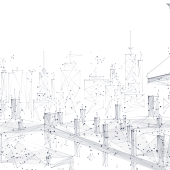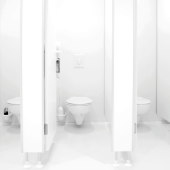Cross Report - Report 886

Confidential Reporting of Structural Safety. Report 886: Unconservative design of flat slab.
A discussion of how a design/modelling problem caused an under-designed reinforced concrete slab to be constructed.
A reporter’s organisation recently came across a design/modelling problem that gave highly unconservative analysis results, causing an under-designed reinforced concrete (RC) slab to be constructed within a large domestic property.
A loadbearing blockwork wall, supported on a transfer slab, was mistakenly modelled as a concrete shell element within a 3D finite element (FE) package, as opposed to a more realistic approach of modelling such walls as a series of pin-ended columns.
When the transfer slab was exported to a 2D FE package for reinforcement and deflection checks, the 3D concrete wall element was converted to a line element of equivalent stiffness and incorporated within the 2D FE analysis.
The result of this was that the transfer slab was artificially stiffened by the line element, which was effectively acting as a very stiff beam with a depth equivalent to the height of the wall over. As such, both the long-term deflection prediction and the reinforcement demand was significantly underestimated.
The already constructed slab was found to have around 50% of the necessary ultimate limit state design reinforcement and was about to receive a 75mm screed. Once the modelling error was discovered, following observed excessive cracking to the supported masonry wall, temporary propping was installed.
A permanent strengthening solution was developed by way of a heavy steel transfer beam, installed below the wall, although ceilings had to be removed and services diverted in order to achieve this.
To avoid such an error, when creating or checking a 3D FE model, it needs to be ensured that any loadbearing masonry wall that is transferred onto a slab below, or that is not vertically continuous down to foundation, is modelled as a series of individual pin-ended columns. This ensures that they act in the vertical loadbearing direction only, and thus cannot act as a deep beam. Wall shell elements within a 3D FE model should only be used where a vertically continuous RC concrete wall is proposed, as, otherwise, they can artificially stiffen the structure by acting as deep beams.
The design checker should also ensure that they see an extruded and annotated view of the 2D model, in order to verify that the structure has been modelled correctly.
Comments
There has been much disquiet expressed in engineering circles about the improper use of (or over-reliance on) computer modelling, with potential for results to be divorced from reality. This report is a classic illustration of the kind of problems that might arise. Safety demands that all model outputs are subjected to a simplified sanity check, which appears not to have happened.
Beyond that, the description of this model suggests an inappropriate level of refinement for the essentially simple task of designing an RC slab supporting a wall. If, however, the slab in question is complex, with, for example, significant openings, then accurate modelling is all the more important.
There were a number of opportunities to discover this mistake. For example, as the wall was in the model, a very quick review of the stresses in the wall would have highlighted that they were inappropriate for a masonry wall. This highlights the need to check the whole model during the design – not just the element of immediate interest. Similar errors can occur when concrete slabs are constructed from precast planks but modelled as a solid diaphragm, leading to an underestimate in the loading to the supporting beams – a check of bending in the slab perpendicular to the span would have highlighted this. It is disturbing that such a slab can be detailed and constructed with only 50% of the required rebar without anyone in the office or on-site thinking it looked odd.
The Standing Committee on Structural Safety (SCOSS) and CROSS have had a longstanding policy of endorsing third-party checks for key structures. There is an overriding need in the construction industry to have sufficient checking by suitably qualified and experienced persons to uncover such serious errors.
Cross Reports are changing
In addition to the reporting of structural safety concerns, the reports will include fire safety issues. At the time of printing, the new-look reports had not been launched, so the above have been taken from 2020 reports. If you would like to receive the CROSS Reports newsletter, visit structural-safety.org/subscribe







